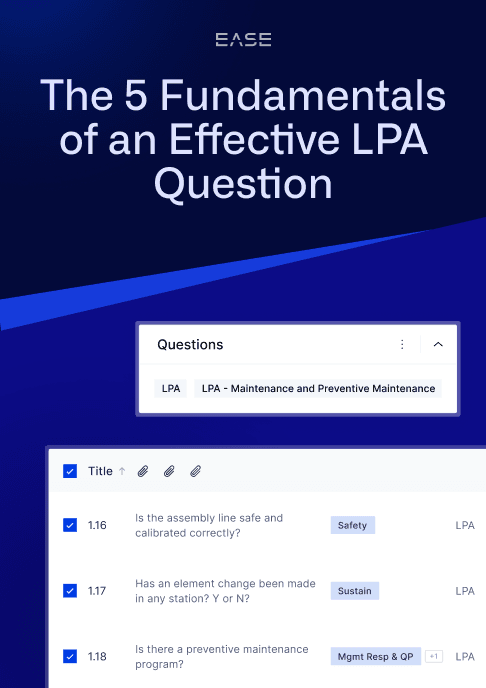7 Things IATF 16949 Auditors Wish Plant Mangers Knew

There’s no question plant managers wear many important hats in a manufacturing facility.
They’re the captain of the ship. They set the tone for a culture of quality. They’re responsible for driving continuous improvement.
In the context of IATF 16949 audits, plant management’s role is welcoming the process as an opportunity to turn over every stone to verify you’re actually doing what you say you’re doing.
Even so, an IATF 16949 audit isn’t something plant managers usually look forward to, given that critical findings can put your certification status at risk.
To help suppliers pass audits the first time, we talked to Denis Devos at The Luminous Group about what IATF 16949 auditors wish plant management knew, including common nonconformances and surprises.
New to layered process audits? Download our free LPAs 101 eBook
1. Management Reviews Should Address Your Biggest Problems
Management reviews tend to focus on performance metrics, but Devos says crises are what should take top priority.
“If you’re perpetually behind during delivery and your relationship with GM is at risk, you should be talking about nothing but that in management reviews,” he says. He adds that while plant managers often take action behind the scenes to get back into a customer’s good graces, these actions tend to be separate from management reviews.
Instead, plant managers should leverage reviews specifically to address these types of problems, put actions in place and manage those actions.
2. A Procedure Does Not Equal a Contingency Plan
One of the most common IATF audit nonconformances relates to contingency plans, with organizations substituting placeholder procedures for actual plans.
“In the old days of the quality system, everything had to be a procedure. That mindset means plant managers often create procedures in place of a real contingency plan,” says Devos.
These procedures say things like, “If we have a natural disaster, we’ll figure it out as we go,” often echoing back the words in the standard. A true plan lists specific actions plant leadership can activate in the event of disruption in order to protect supply.
3. Plant Floor Inspections Should Follow Your Control Plan
The next most common IATF nonconformance deals with plant floor inspections and control plans. Two typical issues are:
- Not conducting inspections at the correct frequency as outlined in equipment instructions
- Not using gauges correctly when conducting checks, or knowing how to respond when an inspection value is out of the acceptable range
4. Don’t Just Check the Box on Corrective Actions
Problems with corrective actions are so common they’re almost a cliché in manufacturing. Prevalent issues include:
- Poor root cause analysis
- Trouble selecting corrective actions that are actually permanent
- Not having robust verification and follow-up procedures
5. You Have to Track Maintenance Goals and Objectives
A big issue Devos sees in automotive manufacturing plants today is that preventive maintenance programs aren’t as strong as they should be, with problems such as:
- Not having a preventive maintenance plan to track maintenance goals and objectives
- Not following the schedule and allowing people to get behind
- Creating the schedule without having a feedback loop in place
“Plant managers often don’t effectively tie preventive maintenance to breakdown maintenance,” he says. “You should be using data to drive changes to the preventive maintenance schedule, doing less or more based on breakdown history.”
6. You Should Know the 10 Leadership Obligations in Section 5.1
Plant managers are responsible for knowing the 10 leadership obligations outlined in Section 5.1 of IATF 16949. Devos points specifically to requirements that leadership promotes the process approach and risk-based thinking.
“Sometimes plant managers are caught flat-footed during the auditor interviews because they don’t have a solid foundation in these concepts,” Devos says. “You can’t promote something unless you understand it.”
7. Layered Process Audit Checklists Should Evolve
Suppliers to GM or Fiat Chrysler are required to conduct layered process audits (LPAs), which focus on fast, high-frequency process verifications to identify sources of variation.
One weakness Devos sees is checklists that never change. Not only does this risk nonconformance with customer-specific requirements under IATF, it also points to ineffective corrective actions.
“Old questions that don’t provide value need to come off the checklists, and you have to add new questions around verification of corrective actions,” he says.
When you don’t routinely update or randomize questions on checklists, it doesn’t facilitate the culture of follow-up necessary to actually drive change in the organization.
Ultimately, says Devos, complying with IATF 16949 comes down to making sure the quality management system (QMS) is embedded in the business.
“It has to reflect reality,” he says. “If the place is burning down around you and you’re not talking about it in management reviews, that’s a problem. You’ve got to live this stuff and integrate it into your daily activities for it to work.”
